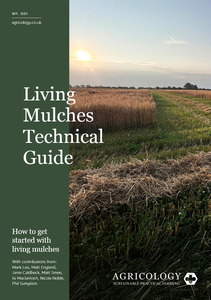{Tool} Living Mulches hub and technical guide. Creator(s): Mark, Lea; England, Matt; Caldbeck, Janie; Smee, Matt; Mackintosh, Isi; Noble, Nicola and Sumption, Phil. Issuing Organisation(s): ORC - Organic Research Centre. (2025)
![[thumbnail of 2025-07-10 16_48_46-8252da527adf511ce51f379bc044b5369cf7613d-3.pdf – Mozilla Firefox.png]](/55988/1.hassmallThumbnailVersion/2025-07-10%2016_48_46-8252da527adf511ce51f379bc044b5369cf7613d-3.pdf%20%E2%80%93%20Mozilla%20Firefox.png)  Preview |
Image (PNG)
- Cover Image
- English
870kB |
Document available online at: https://agricology.co.uk/resource/living-mulches-technical-guide/
Summary
This guide is designed to support farmers in making informed decisions about adopting living mulches in arable systems. It is based on interviews with UK farmers trialling living mulches, alongside four years of research conducted through an Innovative Farmers Field Lab and subsequent studies by the Organic Research Centre. Developed in response to farmers’ questions on how best to implement living mulches, its aim is to provide practical guidance and clarity across the key stages of this novel approach
| EPrint Type: | Practice tool |
|---|---|
| Teaser: | Making informed decisions about adopting living mulches in arable systems. |
| What problem does the tool address?: | Living mulches are semi-permanent legume understories established within cereal crops by undersowing. By the second year, when the living mulch is well-established, further crops are direct drilled into it. This approach sits at the intersection of traditional farming techniques such as intercropping, mulching, cover cropping, and undersowing. When successfully integrated into a system, living mulches offer an opportunity to reduce external inputs and build greater resilience in arable rotations. At their best, living mulches have been shown to improve soil structure, reduce runoff, enhance nitrogen (N) availability for future crops, increase in-field biodiversity, suppress annual weed populations, and lower production costs. However, if not carefully managed, they can compete with crops, cause significant yield penalties, drive up perennial weed burdens, and increase overall costs. |
| What solution does the tool offer?: | There are multiple ways to integrate living mulches, but here, we’ve based the approach on a low-input system and broken down the key stages of the process – outlining the necessary actions, considerations, and potential risks at each step. Alongside this, we’ve included alternative strategies and additional insights for those working within conventional systems. |
| Country: | United Kingdom of Great Britain and Northern Ireland |
| Type of Practice Tool: | Leaflets & guidelines, Web |
| Keywords: | climate change, climate change adaptation, climate-smart agriculture, resilience, cropping syetems, arable farming, weed management, weed control, arable farming, nutrient management |
| Agrovoc keywords: | Language Value URI English climate change http://aims.fao.org/aos/agrovoc/c_1666 English climate change adaptation http://aims.fao.org/aos/agrovoc/c_1374567058134 English climate-smart agriculture http://aims.fao.org/aos/agrovoc/c_1361789093890 English resilience http://aims.fao.org/aos/agrovoc/c_1374480530924 English cropping systems http://aims.fao.org/aos/agrovoc/c_1971 English arable farming http://aims.fao.org/aos/agrovoc/c_36528 English weed management -> weed control http://aims.fao.org/aos/agrovoc/c_8345 English nutrient management http://aims.fao.org/aos/agrovoc/c_330697 |
| Subjects: | Crop husbandry Farming Systems > Farm nutrient management |
| Research affiliation: | European Union > Horizon Europe > OrganicClimateNET > selected tools European Union > Organic Farm Knowledge UK > Organic Research Centre (ORC) |
| Horizon Europe or H2020 Grant Agreement Number: | 101136880 |
| Related Links: | https://organic-farmknowledge.org/tool/55988, https://organicclimatenet.eu/, https://organic-farmknowledge.org/tool/44786, https://organic-farmknowledge.org/tool/30572, https://organic-farmknowledge.org/tool/30573 |
| Project ID: | OFK |
| Deposited By: | Rüger, Madelaine Lea |
| ID Code: | 55988 |
| Deposited On: | 15 Jul 2025 08:14 |
| Last Modified: | 15 Jul 2025 08:14 |
| Document Language: | English |
| Status: | Published |
Repository Staff Only: item control page

 Download Statistics
Download Statistics Download Statistics
Download Statistics
